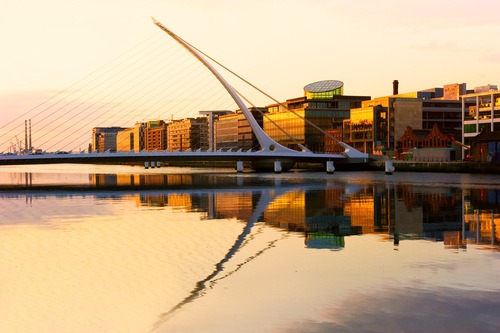Dublin’s docklands, on the north bank of the Liffey estuary, was once a vibrant district of industry and vice. Like in many port cities, the workmen and sailors drawn to the harbour were part of the lifeblood of the economy as well as consumers of its darker underbelly: Monto, a nearby neighbourhood, boasted the largest red-light district in Europe (if not the world) until the beginning of the 20th century.
Walking through the docklands today is a different story. The sailors have largely been replaced by hipsters and bankers who moved into newly constructed apartment blocks during the Celtic Tiger era - the decade of financial growth which made Ireland one of Europe’s richest countries in the 2000s. The area, and its regeneration, is a visual symbol of the transformation of Dublin into the modern cosmopolis which it is today.
 But some things never change. One of the most striking reminders of the past is the famine memorial on Custom House Quay: several bronze statues of emaciated victims of the potato blight of the 1840s, which forced millions of Irish to emigrate to America and elsewhere. Dublin’s port would remain the point of departure for over a century of emigrants, driven by necessity and opportunity to find their fortune abroad. Ireland, an island of less than 5 million people, quickly created one of largest global diaspora populations.
But some things never change. One of the most striking reminders of the past is the famine memorial on Custom House Quay: several bronze statues of emaciated victims of the potato blight of the 1840s, which forced millions of Irish to emigrate to America and elsewhere. Dublin’s port would remain the point of departure for over a century of emigrants, driven by necessity and opportunity to find their fortune abroad. Ireland, an island of less than 5 million people, quickly created one of largest global diaspora populations.
In 2016, empty apartment blocks and sprawling unused office spaces tell the same tale. Ireland remains a nation of emigrants, and the diaspora continues to grow. Following the financial crisis of 2008, Ireland was one of the hardest hit nations in Europe: the banking and construction-fuelled Celtic Tiger turned out to be made of paper, and real GNP fell by 10 percent in just a few years. Bureaucrats from the IMF and European Commission arrived in Dublin to enforce a controversial bailout programme.
Unsurprisingly, emigration boomed. According to a report by the Migration Policy Institute, outflows more than tripled during the period of 2008 to 2012. In the past 6 years, 265,000 left the country, and they continue to leave despite recent upticks in economic performance and the unemployment rate. They are mainly going to same destinations as their predecessors: London, Australia, the US, Canada, all English-speaking places with a history of Anglo-Saxon immigration.
Old story, new trends
The nature and consequences of the flows are shifting, however, perhaps reflecting a broader change in the dynamics of diaspora populations more generally. Firstly, the type of person leaving is no longer from the impoverished working class or rural left-behinds. In many cases (65 percent of those between 25 and 34 years old), the departing citizens held a third-level degree. Many are, or were, young graduates, highly-skilled and educated but emerging to hit the wall of a decimated job market. The booming economies of Australia and Canada, and newer lucrative cities like Dubai or Singapore, swallowed up financial experts and engineers.
Secondly, the pattern of an emigrant is no longer to move to a destination and stick fast. Unlike in the past, the trip to New York does not involve a long, perilous crossing on a rickety famine-ship. New communications, new technology, and advances in transport allow emigrants to live on the other side of the globe without feeling like they have even left home. Popping back is easier, leading to what Marco Funk, of the EU Institute of Security Studies, calls a new pattern of ‘circular migration’: students, skilled workers, and retirees moving in both directions for limited durations.
Finally, this ‘here but not here’ feature of the diaspora has led to a third phenomenon: the increasing importance of exiled Irish in economic and political affairs at home. Many emigrants, planning to return once they have gathered experience and income abroad, still feel like they have a stake in the country’s affairs. Last year, thousands of emigrants, disgruntled about their lack of voting rights in a seminal referendum on marriage equality, launched the ‘Get the Boat to Vote’ initiative: a large-scale campaign to encourage Irish, especially in Britain, to travel home and vote. Thousands did so, and have since pushed for another referendum in 2017 to grant emigrants voting rights from abroad in Presidential elections.
Driving new policies
This is all something which the government has taken to heart. Recognizing the potential of the ‘new’ diaspora as an economic resource and political constituency, it has begun to reach out. In 2009, the first Global Irish Economic Forum was held to tap into the business know-how of expats, and has since taken place biannually. Various grants, including for media to focus on diaspora affairs, have been put on offer. And, two years ago, the first Minister for the Diaspora was appointed, tasked with taking overall charge of engagement efforts: no longer simple cultural ambassadors operating Irish bars abroad, emigrants are economic and political resources to be cultivated.
What this means for the future of citizenship more generally is unclear. As globalization and mobility continue to increase at the same time that walls and borders are being resurrected, diasporas may find themselves becoming pawns rather than players. Similarly, as inequality around the world grows, the economic value of a certain passport may have already started to become more important than its symbolic value. In the Irish case, the sudden influx of British citizens taking advantage of distant relatives to apply for Irish (read, EU) passports in the wake of Brexit is a possible indication of this.
This would not have been something that weighed heavily on the mind of hungry 19th century Irish emigrants. Neither would it have worried the ruling British crown at the time. But in 2016, there is no avoiding the weight of a diaspora in a mobile world; expect more governments to follow the Irish example.
Photo: © Rainprel | Shutterstock


 But some things never change. One of the most striking reminders of the past is the famine memorial on Custom House Quay: several bronze statues of emaciated victims of the potato blight of the 1840s, which forced millions of Irish to emigrate to America and elsewhere. Dublin’s port would remain the point of departure for over a century of emigrants, driven by necessity and opportunity to find their fortune abroad. Ireland, an island of less than 5 million people, quickly created one of largest global diaspora populations.
But some things never change. One of the most striking reminders of the past is the famine memorial on Custom House Quay: several bronze statues of emaciated victims of the potato blight of the 1840s, which forced millions of Irish to emigrate to America and elsewhere. Dublin’s port would remain the point of departure for over a century of emigrants, driven by necessity and opportunity to find their fortune abroad. Ireland, an island of less than 5 million people, quickly created one of largest global diaspora populations.

